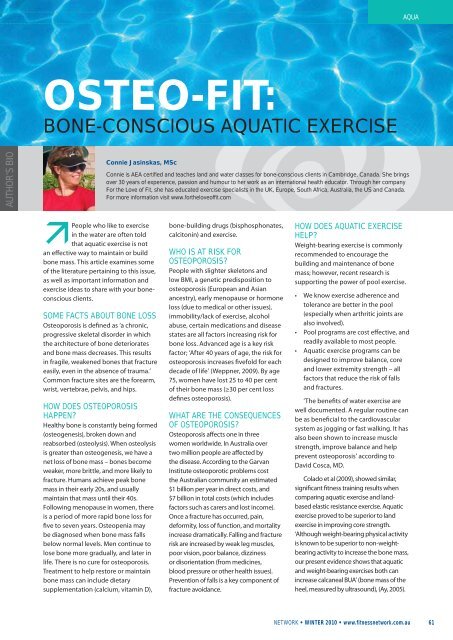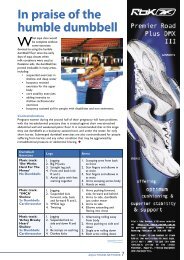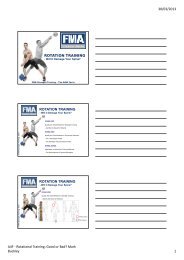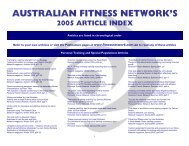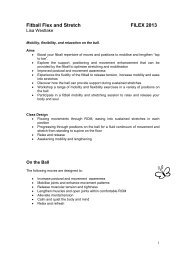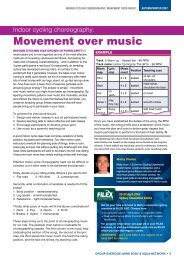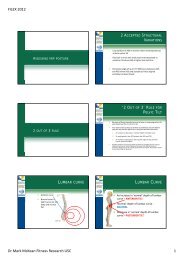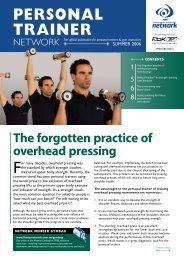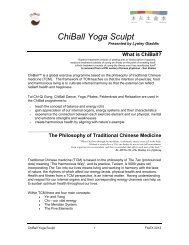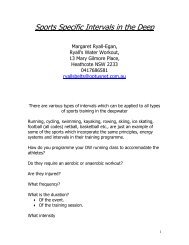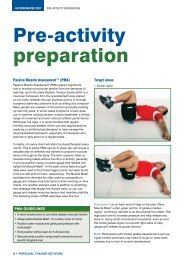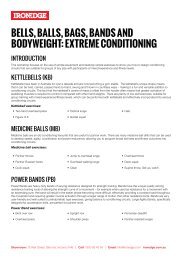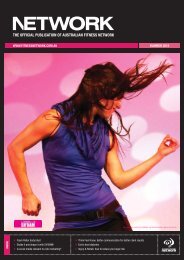CD - Australian Fitness Network
CD - Australian Fitness Network
CD - Australian Fitness Network
You also want an ePaper? Increase the reach of your titles
YUMPU automatically turns print PDFs into web optimized ePapers that Google loves.
AUTHOR’S BIO<br />
OSTEO-FIT:<br />
BONE-CONSCIOUS AQUATIC EXERCISE<br />
Connie Jasinskas, MSc<br />
�People who like to exercise<br />
in the water are often told<br />
that aquatic exercise is not<br />
an eff ective way to maintain or build<br />
bone mass. This article examines some<br />
of the literature pertaining to this issue,<br />
as well as important information and<br />
exercise ideas to share with your boneconscious<br />
clients.<br />
SOME FACTS ABOUT BONE LOSS<br />
Osteoporosis is defi ned as ‘a chronic,<br />
progressive skeletal disorder in which<br />
the architecture of bone deteriorates<br />
and bone mass decreases. This results<br />
in fragile, weakened bones that fracture<br />
easily, even in the absence of trauma.’<br />
Common fracture sites are the forearm,<br />
wrist, vertebrae, pelvis, and hips.<br />
HOW DOES OSTEOPOROSIS<br />
HAPPEN?<br />
Healthy bone is constantly being formed<br />
(osteogenesis), broken down and<br />
reabsorbed (osteolysis). When osteolysis<br />
is greater than osteogenesis, we have a<br />
net loss of bone mass – bones become<br />
weaker, more brittle, and more likely to<br />
fracture. Humans achieve peak bone<br />
mass in their early 20s, and usually<br />
maintain that mass until their 40s.<br />
Following menopause in women, there<br />
is a period of more rapid bone loss for<br />
fi ve to seven years. Osteopenia may<br />
be diagnosed when bone mass falls<br />
below normal levels. Men continue to<br />
lose bone more gradually, and later in<br />
life. There is no cure for osteoporosis.<br />
Treatment to help restore or maintain<br />
bone mass can include dietary<br />
supplementation (calcium, vitamin D),<br />
Connie is AEA certifi ed and teaches land and water classes for bone-conscious clients in Cambridge, Canada. She brings<br />
over 30 years of experience, passion and humour to her work as an international health educator. Through her company<br />
For the Love of Fit, she has educated exercise specialists in the UK, Europe, South Africa, Australia, the US and Canada.<br />
For more information visit www.fortheloveoffi t.com<br />
bone-building drugs (bisphosphonates,<br />
calcitonin) and exercise.<br />
WHO IS AT RISK FOR<br />
OSTEOPOROSIS?<br />
People with slighter skeletons and<br />
low BMI, a genetic predisposition to<br />
osteoporosis (European and Asian<br />
ancestry), early menopause or hormone<br />
loss (due to medical or other issues),<br />
immobility/lack of exercise, alcohol<br />
abuse, certain medications and disease<br />
states are all factors increasing risk for<br />
bone loss. Advanced age is a key risk<br />
factor; ‘After 40 years of age, the risk for<br />
osteoporosis increases fi vefold for each<br />
decade of life’ (Weppner, 2009). By age<br />
75, women have lost 25 to 40 per cent<br />
of their bone mass (≥30 per cent loss<br />
defi nes osteoporosis).<br />
WHAT ARE THE CONSEQUENCES<br />
OF OSTEOPOROSIS?<br />
Osteoporosis aff ects one in three<br />
women worldwide. In Australia over<br />
two million people are aff ected by<br />
the disease. According to the Garvan<br />
Institute osteoporotic problems cost<br />
the <strong>Australian</strong> community an estimated<br />
$1 billion per year in direct costs, and<br />
$7 billion in total costs (which includes<br />
factors such as carers and lost income).<br />
Once a fracture has occurred, pain,<br />
deformity, loss of function, and mortality<br />
increase dramatically. Falling and fracture<br />
risk are increased by weak leg muscles,<br />
poor vision, poor balance, dizziness<br />
or disorientation (from medicines,<br />
blood pressure or other health issues).<br />
Prevention of falls is a key component of<br />
fracture avoidance.<br />
HOW DOES AQUATIC EXERCISE<br />
HELP?<br />
Weight-bearing exercise is commonly<br />
recommended to encourage the<br />
building and maintenance of bone<br />
mass; however, recent research is<br />
supporting the power of pool exercise.<br />
• We know exercise adherence and<br />
tolerance are better in the pool<br />
(especially when arthritic joints are<br />
also involved).<br />
• Pool programs are cost eff ective, and<br />
readily available to most people.<br />
• Aquatic exercise programs can be<br />
designed to improve balance, core<br />
and lower extremity strength – all<br />
factors that reduce the risk of falls<br />
and fractures.<br />
‘The benefi ts of water exercise are<br />
well documented. A regular routine can<br />
be as benefi cial to the cardiovascular<br />
system as jogging or fast walking. It has<br />
also been shown to increase muscle<br />
strength, improve balance and help<br />
prevent osteoporosis’ according to<br />
David Cosca, MD.<br />
Colado et al (2009), showed similar,<br />
signifi cant fi tness training results when<br />
comparing aquatic exercise and landbased<br />
elastic resistance exercise. Aquatic<br />
exercise proved to be superior to land<br />
exercise in improving core strength.<br />
‘Although weight-bearing physical activity<br />
is known to be superior to non-weightbearing<br />
activity to increase the bone mass,<br />
our present evidence shows that aquatic<br />
and weight-bearing exercises both can<br />
increase calcaneal BUA’ (bone mass of the<br />
heel, measured by ultrasound), (Ay, 2005).<br />
AQUA<br />
NETWORK WINTER 2010 www.fitnessnetwork.com.au<br />
61


